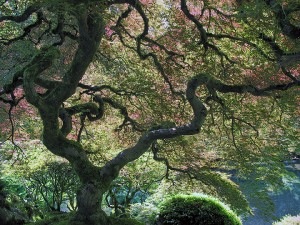Pruning
Origin
Middle English prouynen, probably ultimately from Old French prooignier, alteration of porrooignier, from por- completely (from Latin pro-) + rooignier to cut, prune, from Vulgar Latin rotundiare to cut around, from Latin rotundus round
Definitions
- 1a : to reduce especially by eliminating superfluous matter <pruned the text> <prune the budget>
- b : to remove as superfluous <prune away all ornamentation>
Description
Pruning is a horticultural and silvicultural practice involving the selective removal of parts of a plant, such as branches, buds, or roots. Reasons to prune plants include deadwood removal, shaping (by controlling or directing growth), improving or maintaining health, reducing risk from falling branches, preparing nursery specimens for transplanting, and both harvesting and increasing the yield or quality of flowers and fruits. The practice entails targeted removal of diseased, damaged, dead, non-productive, structurally unsound, or otherwise unwanted tissue from crop and landscape plants. Specialized pruning practices may be applied to certain plants, such as roses, fruit trees, and grapevines. Different pruning techniques may be deployed on herbaceous plants than those used on perennial woody plants. Hedges, by design, are usually (but not exclusively) maintained by hedge trimming, rather than by pruning.
Arborists, orchardists, and gardeners use various garden tools and tree cutting tools designed for the purpose, such as hand pruners, loppers, or chainsaws. In nature, meteorological conditions such as wind, ice and snow, and salinity can cause plants to self-prune. This natural shedding is called abscission.
In general, the smaller the branch that is cut, the easier it is for a woody plant to compartmentalize the wound and thus limit the potential for pathogen intrusion and decay. It is therefore preferable to make any necessary formative structural pruning cuts to young plants, when possible, rather than removing large, poorly placed branches from mature plants.
The general rule of pruning is to always cut in a location where growth will occur, whether the cut is next to a bud or another branch. Cutting a branch beyond where growth will occur will prevent the plant from forming a callus over the cut surface, which in turn will invite insects and infection. It effectively kills all portions of that branch back to the closest branch, bud, or dormant bud clusters, leaving a stub of dead wood. The withered stub will eventually rot away and fall off. All cuts should be relatively smooth since this will aid in healing.
Also, the pruning cut should not be too large when compared to the growing point. For instance, a large cut on a 20 cm trunk down to a 15 cm branch should be fine, but the same cut to the trunk down to a 1 cm twig or bud is considerably less ideal and should be avoided if possible.
Pruning small branches can be done at any time of year. Large branches, with more than 5-10% of the plant's crown, can be pruned either during dormancy in winter, or, for species where winter frost can harm a recently-pruned plant, in mid summer just after flowering. Autumn should be avoided, as the spores of disease and decay fungi are abundant at this time of year.
Some woody plants that tend to bleed profusely from cuts, such as maples, or which callous over slowly, such as magnolias, are better pruned in summer or at the onset of dormancy instead. Woody plants that flower early in the season, on spurs that form on wood that has matured the year before, such as apples, should be pruned right after flowering, as later pruning will sacrifice flowers the following season. Forsythia, azaleas and lilacs all fall into this category.[https://en.wikipedia.org/wiki/Pruning
